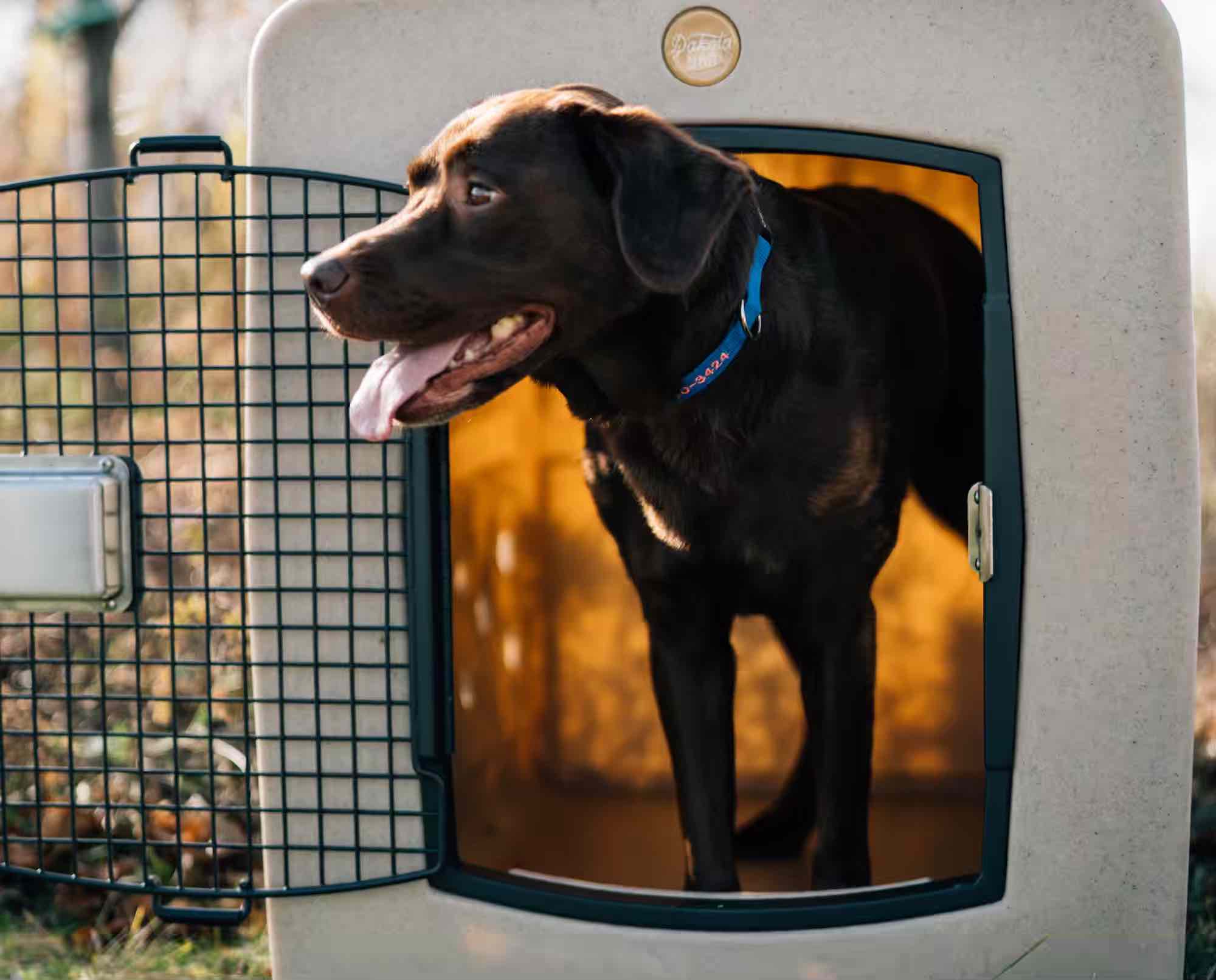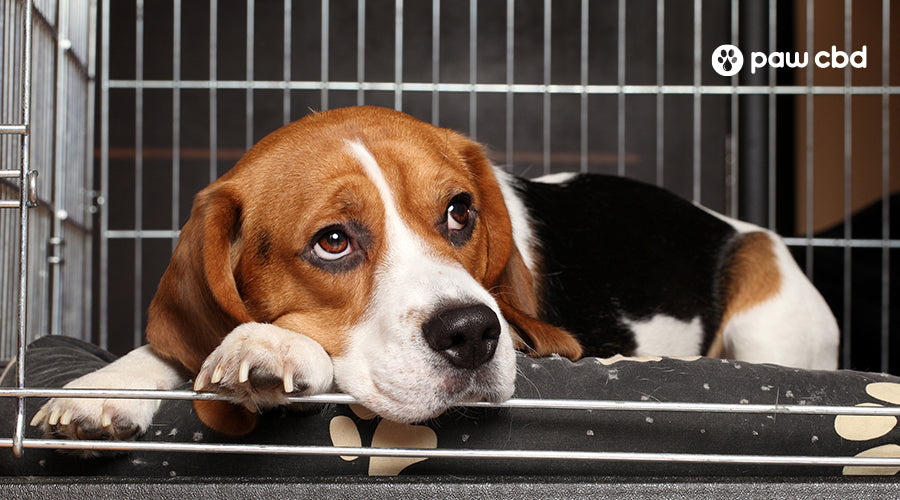To crate train a dog with separation anxiety, start by making the crate a positive, comfortable space and gradually increasing time spent inside. Use treats and praise to create a positive association with the crate.
Place toys and blankets inside to make it cozy. Establish a routine and use the crate for short periods, gradually building up to longer durations to help ease separation anxiety. Crate training a dog with separation anxiety can be a challenging but rewarding process.
Helping your dog feel comfortable and secure in their crate can reduce stress and destructive behavior when you’re not around. By following a structured training plan and using positive reinforcement, you can help your dog overcome their anxiety and feel more at ease when left alone. We’ll explore the steps to crate training a dog with separation anxiety and provide helpful tips to make the process smoother for both you and your furry friend.
Understanding Separation Anxiety In Dogs
Discover effective techniques for crate training a dog with separation anxiety to help alleviate their symptoms and create a safe space for them when you’re away. Gain a deeper understanding of separation anxiety in dogs and learn how to implement positive reinforcement strategies for a happier, more confident canine companion.
Separation anxiety is a common behavioral issue that many dogs struggle with when left alone. Dogs with separation anxiety experience intense distress and fear when their owners are not around. It’s important to understand this condition to effectively crate train your dog and help them feel more secure when you’re not home.Causes Of Separation Anxiety
Separation anxiety can stem from a variety of factors, including: 1. Early Experience: Dogs who were abandoned, separated from their mothers too early, or had multiple homes early in life may be more prone to developing separation anxiety. 2. Lack of Socialization: Dogs that have not been properly socialized or have limited exposure to different environments and people may feel anxious when left alone. 3. Change in Routine: Significant changes in a dog’s daily routine, such as a new job, moving to a new place, or a family member leaving, can trigger separation anxiety. 4. Traumatic Events: Dogs who have experienced traumatic events such as accidents, natural disasters, or abusive situations may develop separation anxiety as a result.Symptoms Of Separation Anxiety
Identifying the symptoms of separation anxiety is crucial for recognizing if your dog is struggling with this condition. Common signs of separation anxiety in dogs include: 1. Barking or howling: Dogs with separation anxiety may bark, howl, or make excessive noise when left alone. 2. Destructive behavior: When anxious, dogs may chew on furniture, scratch doors, or destroy household items. 3. Potty accidents: Dogs with separation anxiety may urinate or defecate indoors, even if they are house-trained. 4. Escaping attempts: Some dogs may try to escape or dig their way out of confinement in an effort to find their owner. 5. Extreme clinginess: Dogs with separation anxiety may constantly follow their owner around and display excessive need for attention. By understanding the causes and symptoms of separation anxiety, you can begin to address this issue and work towards crate training your dog in a way that helps them feel safe and secure when left alone.
Credit: www.wikihow.pet
Benefits Of Crate Training
Crate training is an effective solution for dogs with separation anxiety. It offers several benefits, including creating a safe space, teaching independence, and providing a secure environment for your furry friend. Understanding these benefits can help make the crate training process more effective and rewarding for both you and your dog.
Creating A Safe Space
Crates provide a den-like environment that appeals to a dog’s natural instinct to seek a safe and secure space. By introducing your dog to the crate as a positive and comforting space, you can help alleviate their anxiety when left alone. Moreover, as a safe haven, a crate can prevent destructive behaviors triggered by anxiety, such as chewing on furniture or excessive barking.
Teaching Independence
When used correctly, crate training can help your dog become more independent and comfortable with solitude. This is especially important for dogs with separation anxiety, as it helps them feel secure when left alone. Through gradual acclimatization to the crate, dogs can learn to self-soothe and relax in their own company, reducing their anxiety levels over time.
Step-by-step Guide To Crate Training A Dog With Separation Anxiety
When it comes to crate training a dog with separation anxiety, it’s essential to proceed with patience, compassion, and consistency. By following a step-by-step approach, you can help your furry friend feel more secure and comfortable in their crate, reducing their anxiety and improving their overall well-being.
Choosing The Right Crate
Selecting the appropriate crate is crucial for successfully training a dog with separation anxiety. The crate should be just large enough for your dog to stand up, turn around, and lie down comfortably. A cozy den-like environment can provide a sense of security for your anxious pup.
Introducing The Crate
Introducing the crate to your dog gradually is key. Start by placing the crate in a familiar and positive environment, such as the living room or near their bed. Keep the door open and make the inside inviting by adding their favorite toys or a comfortable blanket.
Gradual Crate Training
Gradual crate training is essential for dogs with separation anxiety. Begin by encouraging your dog to go into the crate voluntarily, using positive reinforcement such as treats and praise. Gradually increase the amount of time they spend in the crate while you’re at home, allowing them to become accustomed to being alone in a safe space.

Credit: projectupland.com
Tips For Success
Looking to crate train a dog with separation anxiety? Follow these tips for success. Start by introducing the crate gradually and associate it with positive experiences. Use positive reinforcement and engage in crate training sessions to help your dog feel more comfortable and secure in their crate.
Repeat the process consistently and patiently, making sure to provide plenty of love and reassurance along the way.
Establishing A Routine
Creating a consistent routine is crucial when crate training a dog with separation anxiety. Dogs thrive on predictability, and having a routine can help alleviate their stress and anxiety. Start by setting specific times for meals, walks, and playtime, and stick to them as closely as possible. This will help your dog feel more secure and provide them with a sense of structure. Make sure to incorporate crate time into your daily routine, gradually increasing the duration as your dog becomes more comfortable. Remember to follow the routine consistently to establish a sense of normalcy for your furry friend.Using Positive Reinforcement
Positive reinforcement is a highly effective technique for crate training a dog with separation anxiety. Rather than using punishment or scolding, focus on rewarding your dog for their desired behavior. Encourage them to enter the crate by placing treats or toys inside, making it an appealing and positive space. When your dog voluntarily goes into the crate or stays calm inside, reward them with verbal praise and a treat. Over time, your dog will associate the crate with positive experiences and feel more at ease when left alone. Patience and consistency are key when using positive reinforcement, as it may take time for your dog to fully adjust.Table: Tips For Crate Training A Dog With Separation Anxiety
| Tip | Description |
|---|---|
| Gradual Introductions | Introduce the crate slowly and gradually, allowing your dog to explore and get comfortable at their own pace. |
| Desensitization | Gradually increase the duration your dog spends in the crate, starting with short periods and gradually extending them. |
| Comfort and Safety | Ensure the crate is comfortable and safe by providing bedding, toys, and ensuring the crate is the appropriate size for your dog. |
| Leaving and Returning | Practice leaving and returning to the crate multiple times a day, gradually increasing the duration of your absence. |
| Avoiding Excessive Attention | Avoid excessive attention or saying long goodbyes, as this can increase your dog’s anxiety when you leave. |

Credit: www.pawcbd.com
Frequently Asked Questions For How To Crate Train A Dog With Separation Anxiety
How Can I Crate Train A Dog With Separation Anxiety?
To crate train a dog with separation anxiety, start by getting them comfortable with the crate. Use positive reinforcement and practice leaving them alone gradually. Make sure their crate is a safe and cozy space, and gradually increase the time they spend inside.
Seek professional help if needed.
Can Crate Training Help A Dog With Separation Anxiety?
Yes, crate training can be a helpful tool for dogs with separation anxiety. The crate provides them with a safe and secure space and can help reduce anxiety when they are left alone. However, it’s important to introduce crate training gradually and consult with a professional if the anxiety persists.
Are There Any Specific Crate Training Techniques For Dogs With Separation Anxiety?
There are specific techniques that can help when crate training a dog with separation anxiety. Gradual desensitization, using positive reinforcement, and creating a relaxed environment are key. It’s important to be patient, consistent, and seek guidance from a professional if needed to ensure the best results.
Conclusion
Crate training is an effective method for helping dogs with separation anxiety feel secure and calm when left alone. By gradually introducing the crate as a positive space, using positive reinforcement, and practicing short absences, you can help your anxious dog become comfortable with being alone.
Remember to be patient and consistent, and seek professional guidance if needed. With time and effort, your furry friend can overcome their separation anxiety and have a happier, more relaxed life.


